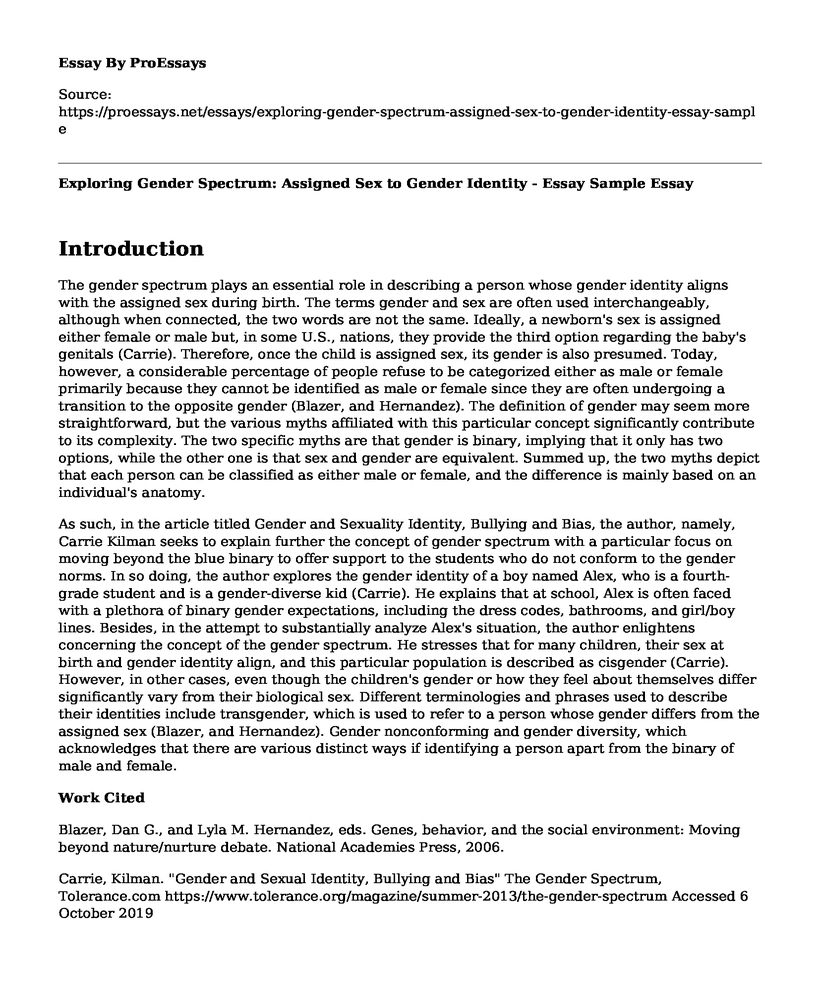Introduction
The gender spectrum plays an essential role in describing a person whose gender identity aligns with the assigned sex during birth. The terms gender and sex are often used interchangeably, although when connected, the two words are not the same. Ideally, a newborn's sex is assigned either female or male but, in some U.S., nations, they provide the third option regarding the baby's genitals (Carrie). Therefore, once the child is assigned sex, its gender is also presumed. Today, however, a considerable percentage of people refuse to be categorized either as male or female primarily because they cannot be identified as male or female since they are often undergoing a transition to the opposite gender (Blazer, and Hernandez). The definition of gender may seem more straightforward, but the various myths affiliated with this particular concept significantly contribute to its complexity. The two specific myths are that gender is binary, implying that it only has two options, while the other one is that sex and gender are equivalent. Summed up, the two myths depict that each person can be classified as either male or female, and the difference is mainly based on an individual's anatomy.
As such, in the article titled Gender and Sexuality Identity, Bullying and Bias, the author, namely, Carrie Kilman seeks to explain further the concept of gender spectrum with a particular focus on moving beyond the blue binary to offer support to the students who do not conform to the gender norms. In so doing, the author explores the gender identity of a boy named Alex, who is a fourth-grade student and is a gender-diverse kid (Carrie). He explains that at school, Alex is often faced with a plethora of binary gender expectations, including the dress codes, bathrooms, and girl/boy lines. Besides, in the attempt to substantially analyze Alex's situation, the author enlightens concerning the concept of the gender spectrum. He stresses that for many children, their sex at birth and gender identity align, and this particular population is described as cisgender (Carrie). However, in other cases, even though the children's gender or how they feel about themselves differ significantly vary from their biological sex. Different terminologies and phrases used to describe their identities include transgender, which is used to refer to a person whose gender differs from the assigned sex (Blazer, and Hernandez). Gender nonconforming and gender diversity, which acknowledges that there are various distinct ways if identifying a person apart from the binary of male and female.
Work Cited
Blazer, Dan G., and Lyla M. Hernandez, eds. Genes, behavior, and the social environment: Moving beyond nature/nurture debate. National Academies Press, 2006.
Carrie, Kilman. "Gender and Sexual Identity, Bullying and Bias" The Gender Spectrum, Tolerance.com https://www.tolerance.org/magazine/summer-2013/the-gender-spectrum Accessed 6 October 2019
Cite this page
Exploring Gender Spectrum: Assigned Sex to Gender Identity - Essay Sample. (2023, Feb 27). Retrieved from https://proessays.net/essays/exploring-gender-spectrum-assigned-sex-to-gender-identity-essay-sample
If you are the original author of this essay and no longer wish to have it published on the ProEssays website, please click below to request its removal:
- Essay Example on Should Women Balance Motherhood and Career?
- Essay Sample on Claude Shannon and Warren Weaver's Model of Communication: Exploring Signal Transmission
- Article Analysis Essay on Profiling Mexican-American Identity
- African & African American Art: A Reflection of Society - Essay Sample
- Essay Example on SPT Theory: Understanding Relationship Development
- Free Essay Sample on Meta-ethics: Exploring Scope, Foundations, and Status of Morality
- Report Sample on Mass Communication on Marginalized Groups







